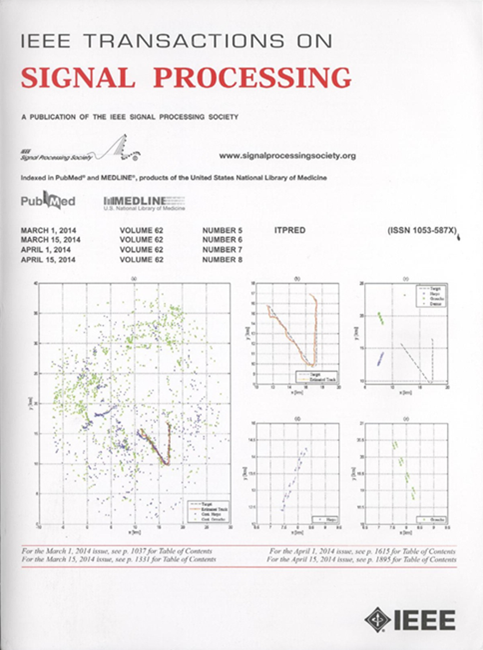超大规模MIMO信号检测的群信息几何方法
IF 4.6
2区 工程技术
Q1 ENGINEERING, ELECTRICAL & ELECTRONIC
引用次数: 0
摘要
摘要提出了一种用于超大规模多输入多输出(MIMO)信号检测的群信息几何方法(GIGA)。信号检测任务被定义为计算所有用户的传输数据符号的后验分布的近似边缘。利用近似边缘,我们执行最大化后验边缘(MPM)检测来恢复每个用户的符号。基于信息几何理论和接收信号分量分组,构造了三种类型的流形,并通过m投影得到了近似的后验边际。引入Berry-Esseen定理提供m-投影的近似计算,而其直接计算是指数级复杂的。在大多数情况下,增加组的数量往往会降低GIGA的计算复杂性。但是,当组的数量超过某个阈值时,GIGA的复杂性开始增加。仿真结果表明,所提出的GIGA算法在少量迭代中就能获得较好的误码率(BER)性能,可以作为一种有效的超大规模MIMO系统检测方法。本文章由计算机程序翻译,如有差异,请以英文原文为准。
Group Information Geometry Approach for Ultra-Massive MIMO Signal Detection
Abstract We propose a group information geometry approach (GIGA) for ultra-massive multiple-input multiple-output (MIMO) signal detection. The signal detection task is framed as computing the approximate marginals of the a posteriori distribution of the transmitted data symbols of all users. With the approximate marginals, we perform the maximization of the a posteriori marginals (MPM) detection to recover the symbol of each user. Based on the information geometry theory and the grouping of the components of the received signal, three types of manifolds are constructed and the approximate a posteriori marginals are obtained through m-projections. The Berry-Esseen theorem is introduced to offer an approximate calculation of the m-projection, while its direct calculation is exponentially complex. In most cases, increasing the number of groups tends to reduce the computational complexity of GIGA. However, when the number of groups exceeds a certain threshold, the complexity of GIGA starts to increase. Simulation results confirm that the proposed GIGA achieves better bit error rate (BER) performance within a small number of iterations, which demonstrates that it can serve as an efficient detection method in ultra-massive MIMO systems.
求助全文
通过发布文献求助,成功后即可免费获取论文全文。
去求助
来源期刊

IEEE Transactions on Signal Processing
工程技术-工程:电子与电气
CiteScore
11.20
自引率
9.30%
发文量
310
审稿时长
3.0 months
期刊介绍:
The IEEE Transactions on Signal Processing covers novel theory, algorithms, performance analyses and applications of techniques for the processing, understanding, learning, retrieval, mining, and extraction of information from signals. The term “signal” includes, among others, audio, video, speech, image, communication, geophysical, sonar, radar, medical and musical signals. Examples of topics of interest include, but are not limited to, information processing and the theory and application of filtering, coding, transmitting, estimating, detecting, analyzing, recognizing, synthesizing, recording, and reproducing signals.
 求助内容:
求助内容: 应助结果提醒方式:
应助结果提醒方式:


